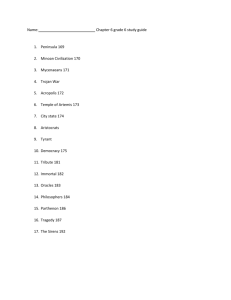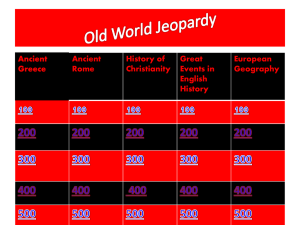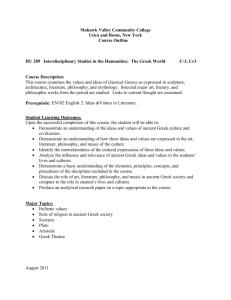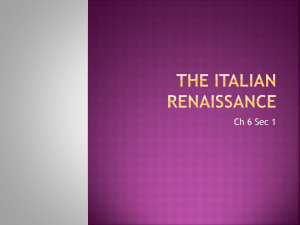Condensed Art History Review: Pre-Historic
advertisement
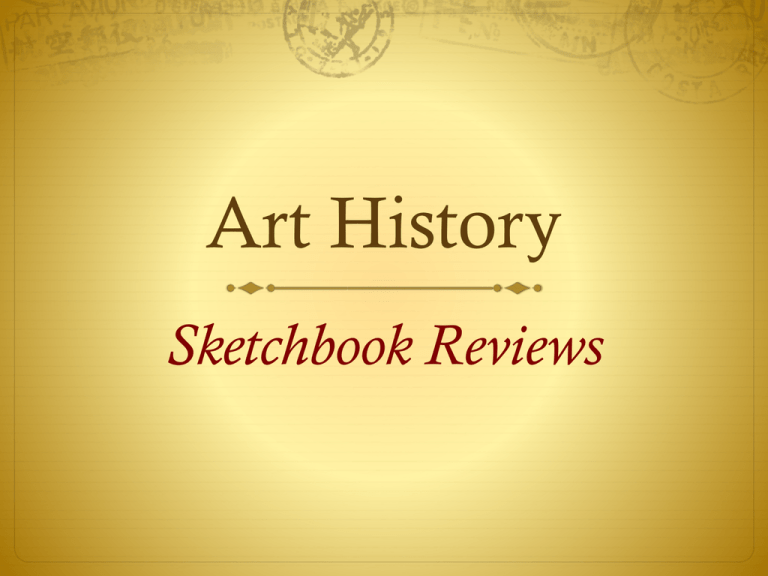
Art History Sketchbook Reviews Pre-Historic Art Europe in 30,000 BC – 2,500 BC Gravettian Culture – Austria Venus of Willendorf 24,000 – 22,000 BC Oolitic limestone – yellowish, traces of ochre One of three figurines recovered from Paleolithic archeological sites at Willendorf in Austria One of many similarly shaped, female carvings known as "Venus Figurines” - found across Europe and made during this time period Discovered in 1908 by Austrian archeologist Josef Szombathy 11 cm high and a max. of 4 cm wide Thought to represent fertility, OR a higher social status – obesity leading to abundance of food, etc. Pre-Historic Art Europe in 30,000 BC – 2,500 BC Southwestern France Caves of Lascaux 15,000 BC painted onto walls using mineral pigments as well as incised into the stone Nearly 2,000 figures, grouped into three categories - animals, human figures and abstract signs Mostly horses (364 total, 90 are stags); also cattle, bison, felines, a bird, a bear, a rhinoceros, and a human One of the bulls is 17 feet long Crossed hind legs show the ability to use perspective No vegetation or environment is portrayed around the animals Discovered in 1940 2000 – fungus appeared; 2006 – black mold; 2008 – cave closed except for 20 minutes once a week to monitor conditions Pre-Historic Art Europe in 30,000 BC – 2,500 BC England, County Wiltshire Stonehenge 3,000 – 2.000 BC Large standing bluestones and sarsen stones set within earthworks 1st phase – a bank & ditch arrangement called a henge, built 5,000 years ago Temple for worship of ancient deities? Astronomical observatory? Prehistoric calendar? Sacred site for burial of high-ranking citizens? 100 feet diameter, 24 feet tall 89 stones weighing up to 4 tons each Years later stones weighing 40-45 tons were moved in Blue stones are made of spotted dolerite (volcanic rock) so rare it’s only found in one known location which is 20 miles west of Stonehenge Non-European Art 30,000 BC – 1,600 CE Benin, Nigeria The Ivory Mask (African) 16th Century Ivory, Iron, Copper Among most celebrated pieces of African art Keep evil away from the Edo peoples Portrait of Idia, mother and close advisor to one of the tribes most powerful leaders Hollowed back suggests that it was both a pendant and a receptacle possibly containing medicines to protect the king during ceremonial occasions 9 3/8 in. tall Top decorated with heads, symbolizing Portuguese – alliance with and control over Europeans Non-European Art 30,000 BC – 1,600 CE Yucatan state in Mexico The Temple at Chichen Itza 750 – 900 CE Stone Large Pre-Columbian city built by the Maya Civilization Famous for it’s “traveling serpent” Step pyramid demonstrates the accuracy and importance of Maya astronomy 365 steps – one for each day of the year… each of the temple’s four sides has 91 steps, and the top platform makes the 365th named one of the New Seven Wonders of the World On Spring & Fall equinox the serpent descends from the heavens along the temple walls As sun sets, shadowy snake descends steps to join a stone serpent head at the base of the staircase Non-European Art 30,000 BC – 1,600 CE China Tomb of Emperor Qin aka The Terracotta Army 246-209 BC Terracotta Sculptures Discovered in 1974 by farmers digging a water well Form of funerary art buried with Qin To protect Qin in afterlife, and to make sure that he had people to rule over Figures vary in height according to roles, with the tallest being the generals Three pits containing the Terracotta Army Over 8,000 soldiers, 130 chariots with 520 horses and 150 cavalry horses, the majority of which are still buried Non-European Art 30,000 BC – 1,600 CE Manufactured in workshops by 700,000 local craftsmen Head, arms, legs and torsos were created separately and then assembled Eight face molds most likely used, and then clay was added to provide individual facial features Vary in height, uniform and hairstyle in accordance with rank – all life-size Most originally held real weapons such as spears, swords, or crossbows Were painted vibrant colors Egyptian 3100 BC – 30 BC Sculptor: Thutmose Nefertiti Bust 1345 BC Limestone, Gypsum, Crystal, Wax, Stucco Nefertiti: literally "the beautiful one has come” The bust is 19 in tall, weighs about 44 lbs Face is completely symmetrical and almost intact, but the left eye lacks the inlay present in the right Pupil of the right eye is of inserted quartz with black paint and is fixed with beeswax Exact function of the bust is unknown, though it is theorized that the bust may be a sculptor's model Egyptian 3100 BC – 30 BC German archaeological team led by Ludwig Borchardt discovered the bust in 1912 in Thutmose's workshop in Amarna, Egypt. Kept in several locations in Germany Was CT scanned in 1992 and 2006 Wrinkles found on neck and bags under her eyes, suggesting the sculptor had tried to depict signs of aging Inner face has creases around her mouth and cheeks and a swelling on the nose Become "one of the most admired, and most copied, images from ancient Egypt” Egyptian 3100 BC – 30 BC West Bank of the Nile in Giza Great Sphinx of Giza, with the Pyramid of Khufu 2558 - 2532 BC Carved Limestone Bedrock Oldest known monumental sculpture Statue of a reclining sphinx (a mythical creature with a lion's body and a human head) 66 feet high and 240 feet long from front paws to tail-end Built by ancient Egyptians during the reign of the Pharaoh Khafra Possibly covered with plaster like bust of Nefertiti Pharaoh Khafre is believed to be the man responsible for building the Sphinx Theory is that the erosion was caused by wind sandblasting the figure, however it was concluded that the erosion was caused by rainfall Egyptian 3100 BC – 30 BC THEORIES: Sphinx was originally a statue of the Jackal-Dog Anubis, the God of the Dead Face was recarved in the likeness of a Middle Kingdom pharaoh, Amenemhet II Traces of paint seen around one of the Sphinx's ears - believe that it was once colorfully painted Egyptian 3100 BC – 30 BC It is not a book – modern name of an ancient Egyptian funerary text Consists of magic spells intended to assist a dead person's journey through the underworld into the afterlife most commonly written in hieroglyphic or hieratic script on a papyrus scroll 190 – 200 spells are known Once prepared, the collection of The Book of the Dead spells was packed carefully away Used from 1550 – 50 BC with their other grave goods, to be written on papyrus and tomb walls placed in their tomb Egyptian 3100 BC – 30 BC They imagined the afterlife as a kind of journey you had to make to get to paradise – but it was quite a hazardous journey so you’d need magical help along the way Papyrus of Ani is one of the finest and most complete examples of this type of Egyptian funerary text to survive. The Papyrus of Ani now resides in The British Museum, London. Greek 850 BC – 31 BC Greek Pottery 1050 – 600 BC Clay, Slip Most of what we know about Greek art comes from the pictures they painted on pottery – about daily life, and they were used in daily life Pots came in all sorts of shapes and sizes depending on their purpose Painted scene reflected what the pot was used for Greek painted pottery changed over time Tells us about how life was in Athens and other ancient Greek cities Greeks believed that goddess Athena invented earthenware pots, and was the patroness of Greek potters Pots are the most valuable tools archeologists use for the study of ancient Greek history Thought of the pots as if they were people - used human terms to describe parts of the pots… mouth, lip, neck, shoulder, and body. Greek 850 BC – 31 BC Periods of Greek Pottery: Protogeometric Geometric Orientalizing Black figure Red figure White ground technique Hellenistic Period Forms of Greek Pottery Amphora – olive oil as prize for winning athlete Krater – for mixing wine with water Kantharos – drinking cup Alabastron – perfumes & oils Hydria – collecting water Greek 850 BC – 31 BC Alexandros of Antioch Venus de Milo 130 – 100 BC Marble Currently at the Louvre Museum in Paris One of most famous works of ancient Greek Sculpture Believed to depict Aphrodite, the Greek goddess of love and beauty She is 6 feet 8 inches high Discovered on April 8, 1820 by a peasant named Yorgos Kentrotas, inside a buried niche within the ancient city ruins of Milos Comprised of several parts which were sculpted separately (bust, legs, left arm and foot) then fixed with vertical pegs, a technique which was fairly common in the Greek world Greek 850 BC – 31 BC She may have held an apple, a crown, a shield, or a mirror in which she admired her reflection. Right side is worked more carefully and finished in greater detail than the left side or back, indicating that the statue was intended to be viewed in profile from its right. Would have been painted, as was the Greek custom for statuary Originally wore metal jewelry – bracelet, earrings, and headband – only the fixation holes remain Greek 850 BC – 31 BC Iktinos, Kallikrates, Karpion The Parthenon 447 – 432 BC Limestone, Pentelic Marble Dedicated to the goddess Athena Pallas or Parthenos Main function was to shelter the monumental statue of Athena that was made by Pheidias out of gold and ivory Temple of the Doric order: 8 columns at the façade and 17 columns at the flanks, conforming to the established ratio of 9:4. *Ratio governed the vertical and horizontal proportions of the temple as well as many other relationships of the building like the spacing between the columns and their height Greek 850 BC – 31 BC All Greek temples designed to be seen only from outside - viewers never entered a temple and could only glimpse the interior statues through the open doors Epitomizes all the ideals of Greek thought during the Classical era through artistic means. Concepts in Athens that set them apart from barbarians: idealism of Greek way of living, attention to detail, understanding of a mathematically explained harmony in the natural world Represented in perfect proportions of building, intricate architectural elements, and anthropomorphic statues that adorned it Roman 500 BC – 476 AC The Colosseum 70–80 AD Built by Emperor Vespasian, finished by Emperor Titus Concrete and stone Roman Art Original name: Flavian Amphiteater Seats between 50,000 and 80,000 people (that’s about as many as Giants Stadium in New Jersey) 4 levels: 3 lower for seating and top level for standing room only 80 entrances, 76 are numbered with corresponding tunnels to assigned seating areas Retractable roof: 160 ft. high (14 stories) 7,500 tons of Travertine stone – was hauled 20 miles from nearby mine 1349 there was an earthquake that damaged the outer wall and builders and thieves stole the broken stone and iron Roman 500 BC – 476 AC Opening of the structure: 100 day celebration in which over 5,000 animals killed and an unknown number of men were killed Hosted gladiatorial battles and hunts with staged elaborate sets and movable trees and buildings Ancient writers recorded that the building was used for simulated sea battles Hundreds of underground tunnels, elevators, and cells were below the amphitheater floor Roman 500 BC – 476 AC Villa of Mysteries in Pompeii 79 AD Pompeii, Italy Fresco Paintings inside done by unknown artist(s) May have been a formal dining room, and is decorated with very fine frescoes Actual subject of the frescoes is hotly debated, most common interpretation is scenes of the initiation of a woman into a special cult of Dionysus – cult that required specific rites and rituals to become a member Other theories: part of a ritual ceremony aimed at preparing privileged, protected girls for the psychological transition to life as married women Each panel depicted a different scene from the ritual, from reading the rites of passage, to the music being played, the gods being present, to the sharing of wine Roman 500 BC – 476 AC Covered in ash and volcanic material from eruption of Vesuvius in 79 AD – frescoes survived largely undamaged. Fresco: technique of mural painting executed upon freshly laid plaster Water is used as the vehicle for the pigment and, with the setting of the plaster, the painting becomes an integral part of the wall. The word fresco is derived from the Italian adjective fresco meaning "fresh” Roman 500 BC – 476 AC Commissioned by Tiberius Augustus of Prima Porta 15 A.D. White marble Based on the Doryphorus, which portrays ideal human proportions of Athenian athlete Portrays him as a victorious General making a speech, posed in the traditional controposto manner Personal features of Augustus: a broad cranium, deep-set eyes, sharp ridges in his brow, a well-formed mouth and a small chin Face depicted in the manner of Apollo was meant to associate Augustus’ abilities with those of the powerful god Augustus wanted to portray himself as a perfect leader with flawless features, showing the power and authority of the man who had the capacity to stabilize an Roman 500 BC – 476 AC Believed that this marble statue may be a copy of a bronze statue that Tiberius’ mother may have had Tiberius made a significant addition to his marble copy on the chest plate he added scenes depicting the Roman victory over the Parthians These scenes were used by Tiberius as a form of propaganda so that the viewer would recall the important role his father played in securing the Roman empire Barefoot Augustus as well as Cupid on the dolphin hint at the ancestry to the goddess Venus Medieval 500 – 1400 Illuminated Letter & Manuscripts Italy 400 – 600 Papyrus, Vellum, Parchment, Gold, Silver, Ink & Quill Decorated with gold or silver – costly process reserved for special texts Written and decorated by hand Most common item to survive the Middle Ages; generally religious in nature Early versions were Gospel Books, but later versions included complete Bibles and personal devotion books Monasteries produced manuscripts for their own libraries, wealthy individuals commissioned works as a sign of status within the community Medieval 500 – 1400 Parchment is high quality writing support made from the specially prepared skins of calves, sheep, or goats Pigments used in illumination were ground up or soaked out vegetable, mineral, and animal extracts Production was divided among four distinct craftsmen: the parchment maker, the scribe, the illuminator, and the bookbinder Parchment maker prepared the animal skins used to make the leaves of a manuscript Scribe wrote the manuscript's text by hand Illuminator provided the manuscript's painted decoration Bookbinder provided a binding to protect the manuscript, which held the leaves together and kept them from curling Medieval 500 – 1400 Stained Glass 10th – 16th Centuries Glass, sand, ash, paint Pictorial art form using colored and painted glass Used mostly in churches, but also wealthy settings and public buildings Purpose was to enhance the beauty of the setting and to inform viewers via symbolism and narratives French clergyman Abbot Suger wanted to build a cathedral that would uplift the spirit by bathing worshippers in brilliant colored light. The stained glass windows were like luminous paintings, depict stories from the Bible and drawing the gaze upward toward heaven. Medieval 500 – 1400 Medieval 500 – 1400 Traditional Christian subject matter – Virgin Mary with Christ Child on her lap, they are surrounded by saints and angels Originally painted for the Ognissanti Franciscan church in Florence Giotto took influence from many art forms, styles and artists of his time, but he was the first to depict 3-Dimensional figures in Western European art Fabric folds are realistic – instead of lines he used light, shadow, and color to create the appearance of fabric; contours of the body Giotto di Bondone underneath the fabric folds are also visible Ognissanti Madonna, Uses chiaroscuro (the use of contrasts of light) aka Madonna Enthroned to achieve a sense of volume in figures, giving them the slight smokiness that is usually 1310 characteristic of later Renaissance artists Tempera on Panel Medieval 500 – 1400 Renaissance 1400 – 1500 Baroque 1600 – 1750 Impressionism 1865 – 1885 Post-Impressionism 1885 – 1910 Expressionism 1900 – 1935 Cubism 1905 – 1920 Surrealism 1917 – 1950 Abstract Expressionism 1940s – 1950s Pop Art 1960s Assemblage 1970 + Recycled 1970 +
